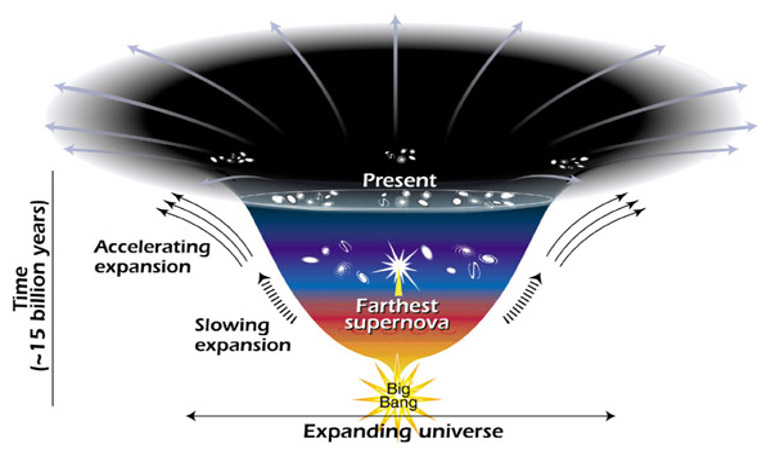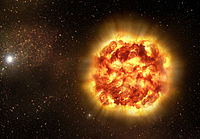The quickening development of the universe is the perception that the extension of the universe is to such an extent that the speed at which a far off cosmic system is subsiding from the eyewitness is constantly expanding with time.
The quickened development was found amid 1998, by two autonomous activities, the Supernova Cosmology Project and the High-Z Supernova Search Team, which both utilized far off sort Ia supernova to quantify the acceleration. The thought was that as sort 1a supernovae have nearly the equivalent natural brilliance (a standard flame), and since articles that further away seem dimmer, we can utilize the watched splendor of these supernovae to gauge the separation to them. The separation would then be able to be contrasted with the supernovae’s cosmological redshift, which estimates how much the universe has extended since the supernova occurred. The surprising outcome was that objects known to mankind are moving far from another at a quickened rate.
Cosmologists at the time expected that subsidence speed would dependably be decelerating to the gravitational fascination of the issue known to man. Three individuals from these two gatherings have consequently been granted Nobel Prizes for their discovery. Confirmatory proof has been found in baryon acoustic motions, and in examinations of the grouping of cosmic systems.
Supernova observations.
The first evidence for acceleration came from the observation of Type Ia supernovae, which are exploding white dwarfs that have exceeded their stability limit. Because they all have similar masses, their intrinsic luminosity is standardizable. Repeated imaging of selected areas of the sky is used to discover the supernovae, then follow-up observations give their peak brightness, which is converted into a quantity is known as luminosity distance. Spectral lines of their light can be used to determine their redshift.
Bryon acoustic osscillations
In the early universe, before recombination and decoupling occurred, photons and matter existed in a primordial plasma. Purposes of higher thickness in the photon-baryon plasma would contract, being compacted by gravity until the weight turned out to be excessively substantial and they extended again. This constriction and extension made vibrations in the plasma similar to sound waves. Since dim issue just communicates gravitationally it remained at the focal point of the sound wave, the cause of the first overdensity. While decoupling happened, around 380,000 years after the Big Bang, photons isolated from the issue and could stream uninhibitedly through the universe, making the astronomical microwave foundation as we probably are aware it.
This left shells of baryonic matter at a fixed span from the overdensities of a dull issue, a separation known as the sound skyline. As time passed and the universe extended, it was at these anisotropies of issue thickness where systems began to shape. So by taking a gander at the separations at which worlds at various redshifts will in general bunch, it is conceivable to decide a standard precise measurement separation and utilize that to contrast with the separations anticipated by various cosmological models.
Dark energy
The most imperative property of dim vitality is that it has negative weight (frightful activity) which is circulated moderately homogeneously in space.
P=wc^2p
where c is the speed of light and ρ is the vitality thickness. Diverse hypotheses of dull vitality recommend distinctive estimations of w, with w < − 1/3 for vast speeding up. The most straightforward clarification for dull vitality is that it is a cosmological steady or vacuum vitality; for this situation w = −1. This prompts the Lambda-CDM display, which has for the most part been known as the Standard Model of Cosmology from 2003 through the present since it is the least difficult model in great concurrence with an assortment of late perceptions. Riess et al. discovered that their outcomes from supernovae perceptions favored growing models with positive cosmological consistent (Ωλ > 0) and a current quickened development (q0 < 0).
Phantom energy
Current perceptions permit the likelihood of a cosmological model containing a dull vitality part with the condition of state w < −1. This ghost vitality thickness would end up unbounded in limited time, causing
such a gigantic gravitational aversion, that the universe would lose all structure and end in a Big Rip. For instance, for w = − 3/2 what’s more, H0 =70 km·s−1·Mpc−1, the time staying before the universe finishes in this Big Rip is 22 billion years.
Theories for the consequence to the universe As the universe extends, the thickness of radiation and standard dull issue decays more rapidly than the thickness of dim vitality and, in the long run, dim vitality commands. In particular, when the size of the universe pairs, the thickness of issue is decreased by a factor of 8, yet the thickness of dim vitality is about unal-tered (it is actually steady if the dull vitality is a cosmological consistent).
In models where dull vitality is a cosmological consistent, the universe will extend exponentially with time in the far future, coming ever nearer to a de Sitter spacetime. This will, in the long run, lead to all proof for the Big Bang vanishing, as the inestimable microwave foundation is redshifted to bring down forces and longer wavelengths. In the long run, its recurrence will be low enough that it will be consumed by the interstellar medium, as for being screened from any onlooker inside the universe. This will happen when the universe is under multiple times its present age, prompting the finish of cosmology as we probably
An always growing universe with non-zero cosmological steady has mass thickness diminishing after some time, to a dubious moment that zero issue thickness is come to. Every issue (electron, protons, and neutrons) would ionize and break down, with articles disseminating without end.
Options for a definitive destiny of the universe incorporate the Big Rip referenced over, a Big Bounce, Big Freeze or Big Crunch.




